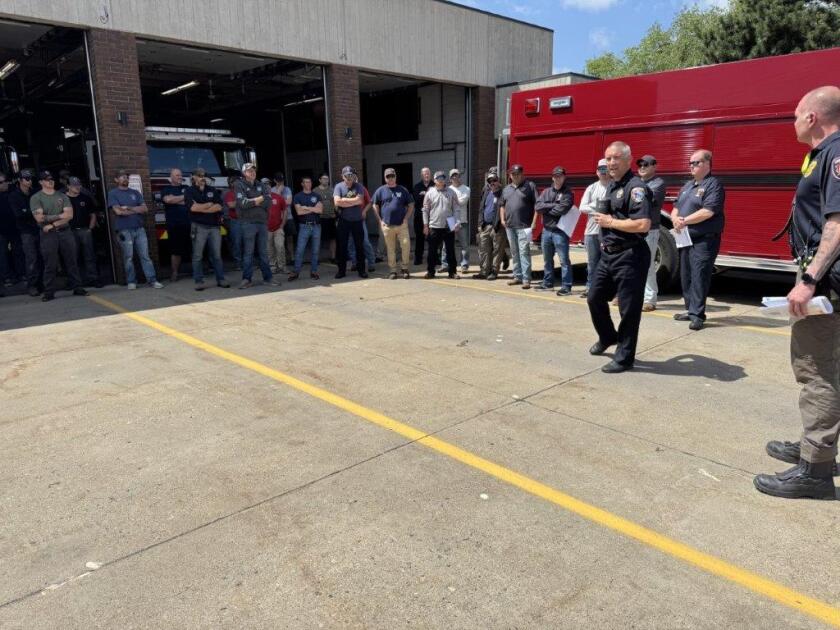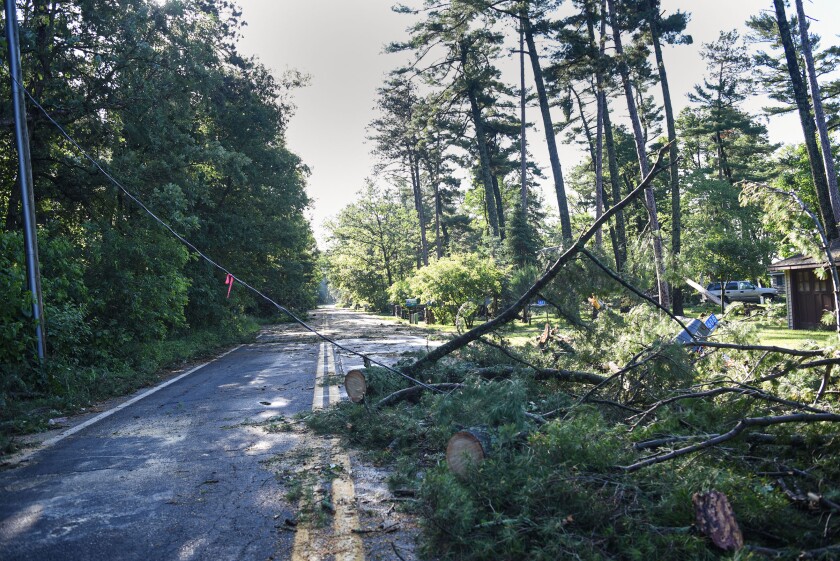BEMIDJI — Erik Flowers has frequented Bemidji a time or two.
One of Brainerd’s paid on-call firefighters routinely finds himself in Beltrami County each spring for his day job. So when Flowers volunteered for a day-long firefighting shift in Bemidji in the wake of the severe storm on June 21, he was taken aback by the aftermath as he traveled up Highway 371.
ADVERTISEMENT
“I was up in Bemidji this spring for a work conference; we go up every year. I’m familiar with the area,” Flowers said. “We got to Walker and the power was still out. I kind of thought, ‘This is a lot bigger than we imagined.’ ”
Flowers and the rest of the four-person crew didn’t know what was waiting for them 40 miles north of the halfway point between Bemidji and Brainerd.
“You get into Bemidji and you start seeing the damage from roofs being torn off on so many buildings and the amount of trees on the side of the road,” he continued. “You’re just in awe of how much damage there is.”
Flowers’ shock matched that of roughly 100 traveling firefighters who answered Bemidji’s call for help. At about 8 a.m. on June 21, six hours after Category 3 hurricane winds tore the First City on the Mississippi apart, Bemidji Fire Chief Justin Sherwood sought a lifeline in the form of mutual aid.
“We have 10 mutual aid partners around us — Solway, Blackduck, etc.,” he said. “If they have a structure fire, they can request resources from Bemidji. For this event, we opened up intrastate requests so we could receive aid from everywhere. We had 19 departments come to assist us, all the way down to Bloomington and Little Canada.”
In a matter of hours after the storm dissipated, before any power was reestablished or emergency resource centers were posted, firefighters from Bemidji, the surrounding area and Greater Minnesota got their hands dirty in the early phase of a relief effort that will take weeks, if not months or years, to complete.
From gas leaks to structure fires, from the sense of helplessness to faith restoration, the preparation from statewide departments readied firefighters for the unpreparable.
ADVERTISEMENT
Acting fast
Sherwood went to bed on Friday, June 20, anticipating being woken up with calls.
“You just get that feeling sometimes,” he said. “When you have a major storm, there’s often a structure fire. At minimum, you’re getting alarms. You just know it’s coming.”
Around 2 a.m. on Saturday, as Sherwood began his trek inside Bemidji’s city limits, he quickly learned that it wasn’t an average storm.
All available firefighters in the existing crew of 57 were paged in. Sherwood also said the department’s communications were down.
“I was really proud of my staff, because they had already coordinated dispatch logs,” he said. “They had all of the calls written down on pieces of paper because the dispatchers were so inundated with calls. They were prioritizing those logs on paper, and Chad Hokuf was dispatching rigs over the radio.”
In the immediate eight hours following the storm, Bemidji firefighters responded to roughly 80 emergency calls. Each rig in the station was deployed to various areas of Bemidji, attending to gas leaks, dangerously fallen power lines and other time-sensitive fixes.

Sherwood was forced to delegate.
ADVERTISEMENT
On his drive into Bemidji from his home in rural Beltrami County, he called in each city department lead for an emergency meeting at 3 a.m. Sherwood, the emergency city manager, passed off the immediate recovery duties at the fire department to Hokuf.
“It was at that point when we identified the streets that needed to be opened and the injuries and casualties we had,” Sherwood said. “We didn’t have any, thank God. But it was dark, and there wasn’t power, so we didn’t even know what we had to work with.
“When you look at it from an administrator’s point of view, like myself, I was thinking more long-term. I knew we couldn’t sustain this pace, and what if the ‘what ifs’ happen?”
At 8 a.m., one of them happened.
Bat signal
Due to a building explosion on the north side of Bemidji near Sanford, the fire department was suddenly strapped for bodies.
In times of desperation, local fire departments can reach out to their mutual aid partners for help. In extreme cases, like Bemidji’s, requests through the Minnesota Intrastate Mutual Aid Plan are formed.
Chiefs from around the state assess their departments to see if they can send a crew where it’s needed on short notice.
ADVERTISEMENT
Sherwood also reached out to the Minnesota State Fire Chiefs Association for assistance. Hibbing Chief Erika Jankila; Cross Lake Chief Chip Lohmiller; Pequot Lakes Chief Mike Schwankl; Cross Lake Deputy Chief Jory Danielson; Plymouth Chief Rodger Coppa; Brooklyn Park Chief Tim Walsh; Bloomington Deputy Chief Jay Forster; Little Canada Chief Don Smiley; and Brooklyn Center Chief Todd Berg all provided aid to Bemidji in the days following the storm.
Due to the scale of the destruction, several department authority figures were needed.
“I knew our resources were going to be tapped,” Sherwood said. “We couldn’t sustain what we were doing. We pulled the pin in the mutual aid grenade, if you will, and called Blackduck, Solway and Cass Lake. But I also had to be mindful of what their communities had going on. This became a state event.”
Sherwood came away impressed with how quickly they responded to the call to service in northern Minnesota.
“I made one phone call to a supervisor at the state fire marshal’s office,” he said. “I told him what I needed, and he said, ‘I got you.’ He told me they had six fire departments signed up for three days each, and if I needed anything else, they’d get it for me. That was done within hours.
“It just blows my mind how fast it all came together. How did they get here that fast? How were they even able to pack that fast? It’s hard to understand, but it makes you so proud of what you do. We’re the state of community.”

While stations from around Minnesota boarded their trucks, a crew in Detroit Lakes was short on bodies.
ADVERTISEMENT
Mike Hansen, the Detroit Lakes fire chief, didn’t have four people to send to Bemidji. He teamed up with Fergus Falls to provide aid.
“When I called their chief, Ryan Muckow, he said they had the manpower but they were down an engine,” Hansen said. “I told him that we had the engine but we didn’t have the manpower. He sent us two guys and we put them on our engine.”
Hansen is familiar with mutual aid and intrastate requests. He understands that rural towns in Greater Minnesota don’t have the infrastructure to survive the aftermath of the June 21 storm alone.
“I don’t even know if there was a reaction,” Hansen said. “All of us are trained. We know when to call for help, and we know when not to call for help. When one of the other chiefs calls for help, you don’t ask questions. You just do it because you know it’s needed, and you might need it, too, at some point.”
Gas leaks
With an influx of emergency calls rolling through the dispatchers — calls that were being documented on pen and paper, as the town was without power — Bemidji firefighters leaned on their mission statement.
“It’s to protect life, then property, then the environment,” Sherwood said. “Life safety is No. 1. That’s how we prioritize calls. In everything that was done, that was the priority. It wasn’t until the daylight came that we started shifting. … For us, a lot of the life safety things were gas leaks, lines down and collapses.”
In a standard June week, gas leak calls are few and far between. In the 10 days following the storm, Sherwood guessed that Bemidji received 50-60 calls about gas leaks.
ADVERTISEMENT

“We work our way out from the hot zone through our monitoring systems,” Sherwood said. “You have to identify the type of gas — natural gas or propane gas — which have different kinds of gravities. Natural gas is lighter than air and will dissipate, whereas propane gas sinks low. We identify those things and act accordingly.”
Gas leaks can arise from virtually all areas in a community. In the restoration process, more leaks than the original source can be found.
“You think about the amount of wind we had, it moves and shakes things,” Sherwood said. “We had gas leaks on top of Lueken’s and Walmart. That’s where their appliances are. Trees had fallen on power lines, so we took care of those. Then we turn the gas back on and identify more leaks.”
New normal
Since pushing through the immediate recovery phase, Sherwood is turning his department’s attention toward regaining a semblance of regularity.
He is a believer in leading by example. He understands that while some community members will endure an ongoing struggle in the coming months, reestablishing structure in his department is paramount.
“It’s important to say that there are so many community members who weren’t thriving before the storm,” Sherwood said. “They were struggling, whether it be financially or otherwise. At the very least, we need to get people back to a place of familiarity. It’s going to take patience, grace, resiliency, love — a lot of outward stuff.
“From the fire department’s point of view, we’re of the mindset that, right now, we’re in the recovery stage. The recovery items that happen right now don’t involve us unless there’s an injury or something like that. We’re working on recognizing what our new normal is now. … We’re going to continue to support our service organizations here in Bemidji.”
Sherwood has also had time to reflect. In a time where it feels like Bemidji drew the short end of the weather stick, he understands how lucky Bemidjians got with the lack of casualties.
“I think a big part of that is because of the time the storm came,” Sherwood said. “People were at home in their beds or found shelter. The sirens went off and gave people enough of a heads-up to retreat somewhere safe. But when you wake up and see the damage the next morning, you expect multiple casualties, whether that’s injury or death.”
As for the visiting firefighters who volunteered their efforts in the days following the storm, Flowers leaned on the unspoken code among first responders.
“Most firefighters have that deep level of service and a commitment to helping others,” he said. “It’s not constrained to a boundary or a state, or any of that kind of thing. For me, I feel like I was born to serve others.
“Every time I try to branch out in my career that isn’t paid-on-call firefighting, it always leads back to serving others. I believe stuff like this goes so far beyond the boundaries of our own town in Brainerd.”

It isn’t lost on Sherwood that the town-shaping disaster could take an emotional toll on his crew. He called himself “passionate” in his leadership style, and the response of his counterparts in a time of need reaffirmed his enthusiasm for what he does.
“For them to leave their lives and families, to leave what they had damaged and lost from this storm, all to help other people, I couldn’t ask for anything more out of them,” Sherwood said. “We didn’t just see this with emergency staff; we saw it throughout the community. People came out and assisted their neighbors before they helped themselves. That’s why you can drive down these streets today.”













